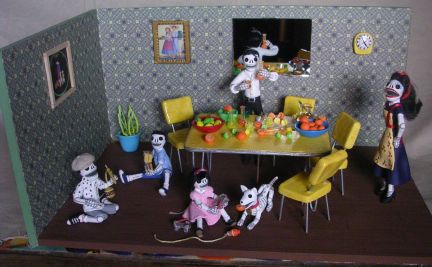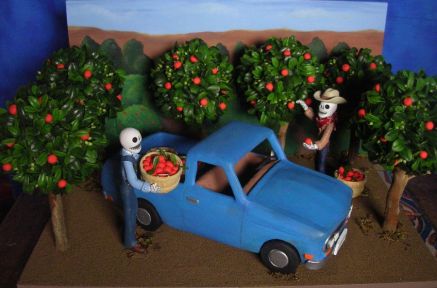EDITOR’S NOTE: I actually wrote this piece about a month ago–while sifting through the mush of what was left of my brain and preparing to book my tickets to California for The Folk Tree’s exhibition–and then promptly forgot about it, in the midst of the hubbubbery of the weeks that followed.
As I don’t really have much profundity left in the tank for today–but would like to light my candles for the occasion, all the same–I’m going to go ahead and let loose with it, sans further revision. I think the point it makes is a sage one, and after having been heartwarmed by the wonderfully invested and encouraging reception in Pasadena (Including the sales of at least three of my featured pieces!), its basic premise ring-a-ding-dongs with a taste of truth.
Mr. Lou and I have recently been kicking around the great question of artistic identity and credibility in relation to the “muerte arts” in the comments section of this fine blog, with one of the primary nuggets of discussion relating to my recent struggles to find a “resting place” for my work, especially in light of the upcoming holiday. I thought I’d take his kind offer to run with editorial talking-stick and expand on that experience a bit, as well as a few other related scattershot thoughts that I’ve scraped together on the topic.
As I’ve mentioned in my own blog, I’ve been graced with the chance to exhibit my work at The Folk Tree in Pasadena this year, which—for me—is equal parts homecoming, as well as the fulfillment of an artistic mission. For my dollar, there exists no other folk art entity so devoted to the betterment not only of international practitioners of the “dia de los muertos” art form and its numerous peer genres (Oaxacan sculpture, tinsmithing and native Mexican woodworking, for example), and my own interest in the craft can be traced back to the many afternoons that I spent there, wandering the aisles and staring, slack-jawed, at the curios on display*.
So with that duly noted, it may be a bit shocking that The Folk Tree was NOT my first choice, in terms of display queries… though not for the reasons that might immediately come stampeding forth. The blunt fact is that I didn’t think my work was good enough to sit alongside shelves reserved for the ofrendas of actual native artisans, jockeying for attention alongside the works of the contemporary Linares clan; this wasn’t due to some lapse in artistic confidence—not this week, anyhow—but rather the ongoing, craw-boning issue that I find myself facing as a self-identified Russian-American white guy who happens to be deeply and personally invested in what is, objectively speaking, an wholly “repurposed” form of international art.
It’s tough to talk turkey on this issue without feeling like I’m somehow struggling towards qualifiers**, honestly. It isn’t something that sits heavily on my conscience or which I try to infuse into my works; I love calacas because of what they represent in their most essential form (and because they’re one of the few forms of raw artistic expression that I’ve ever been truly good at), not because I’m deeply invested in the related trappings of sociopolitical stances and commentary. For me, the act of creation is a self-contained one: I sculpt for the sake of sculpting, and—more often than not—leave the conclusions to be drawn by the people who stop to take a look at the resulting work, be in in realtime or in the virtual arena.
This sense of autonomy is a luxury, though I’m prone to forgetting that… until reminded otherwise. This was the proverbial “tale of the tape” through late August and early September, as I went through the motions of contacting five or six local, Seattle-area folk art shops, and inquiring as to whether or not they would have any interest in including my calaveras with their dia de los muertos displays***. In every case (Save for two whose business licenses require that they only sell legitimate import work), the initial contacts resulted in an expression of interest, all of which quickly dried up the moment that it was revealed that I was not only local, but not Hispanic. This wasn’t overtly or explicitly stated at any point (Hell, most of them just stopped responding to e-mails the moment that the cat was out of the bag), but the general feeling had a familiar kind of weight to it. In a sense of summary:
“Good for you, but that’s not really our thing…”
Now, let me take a moment to get the nines straight, in terms of this thinking. I don’t actually have any sort of issue with it, in bare principle; if the modus operandi of an individual who runs such a business is to exclusively show the work—whether based on appreciation of certain aesthetics, or a sense of investment in the international artistic community—of Hispanic artists, then that’s exactly what they should be doing. The highest possible function of an art gallery or folk arts importer is to expand their customers’ exposure to—and understanding of—outsider forms of expression, whether indigenous in nature or simply alternative in their creative aesthetic. And given the unparalleled amount of investment that this region provides for its Native artists, it’d be a qualified oversight to imply that the gallery culture, as a whole, was somehow lacking…
… but that doesn’t really do much to address the fact that the majority of the calaca-related pieces that are offered by these dealers have the care and craft of a deep-fried cerote****. I’d have absolutely nothing to get wound up about if the shelf space reserved for ofrendas and calaveras were being put to proper use, showcasing the creative fruits of legitimate bonesmiths: instead, they’re clogged up with dime-quality sweatshop garbage, overpriced and sloppy “worry-men” style skeletons, and the prerequisite liquid clay-injected catrinas, all obscenely “marked up” due to the fact that they’re “imported,” ostensibly from somewhere that’s, you know, not within driving distance. That’s worth at least a 35% gouge, right?
So, I don’t know. What this is all wending towards is the big question of what really constitutes a “legitimate” practitioner of dia de los muertes-related crafts. To look around Seattle, one can’t help but to come away with the overbearing sense that the city’s “profile” for a legitimate muerte artist—at least in terms of gallery and show cred—requires an appropriately exotic pedigree (or at least an address near Sonora), in order to make the cut… while in Southern California—the cradle of Chicano creativity, the greatest diaspora of Latino culture in this entire country and the epicenter of the Mexican-American rights movement—it’s the quality of the work that wins out, rather than the color of the artisan’s skin.
The brushstrokes being applied here are naturally broad, but it makes me thankful for the opportunities that I’ve been provided with. I love my city of endless rain and glorious gloom, but I won’t weep for the fact that there’s no support for what I do here: I’ll simply kick on like a tumbleweed, and send my little bonemen and bonewomen off to a sunny place where who I am is of less importance than the love I put into my work*****.
*This year’s show did not disappoint, in that regard: if you were to artfully smash up the eccentric fun of the Honeyduke’s candy shoppe from the Harry Potter flicks with some of the finest alebrijes and ofrendas imaginable, you’d get a good sense of just how cool this exhibition was. A huge nod of gratitude and mild awe to Gail Mishkin for what must have been an absolutely exhausting organization process.
**Much like some whiskey-tanned Arizonian who sports plenty of tarnished silver and turquoise and talks about the Latinos and Res folks that he’s “friends with” while casually voting Republican. It’s an absurd #whitepersonproblem, but is–nevertheless–something I find myself tussling with, routinely.
***The majority of which are basically the same displays that are up for the duration of the calendar year, with the addition of some slap-assed, poster-paint “DIA DE LOS MUERTOS!” sign tacked up over them. Having spent the recent holiday weekend cruising the Olympic Peninsula–and being staggered by the beauty of the tribal art galleries that are peppered along the main inroads between Sequim, Port Angeles and Forks–this bit becomes even more mortifying.
****There were only two exceptions to this apparent rule, both of which are nestled within the confines of the Pike’s Market sprawl (and both of which deal in quality goods, regardless of the season). At the very least, I can nose up all this highfallutin disgust by noting that Seattle’s most high-profile purveyors of Oaxacan goods saw fit to rise to the occasion in an appropriately festive fashion.
*****Which, in another note of ironic hindsight, may include at least one high-profile outlet on Olvera Street. In keeping with the unspoken trend of this trip, a casual conversation about las calaveras with the shop’s owner turned into a potential consignment opportunity. If there was an issue with my lumbering around the joint looking like an un-sunned sasquatch who happened to have Mexican folk arts on his resume’, then it certainly didn’t rear its head as an issue du jour.

